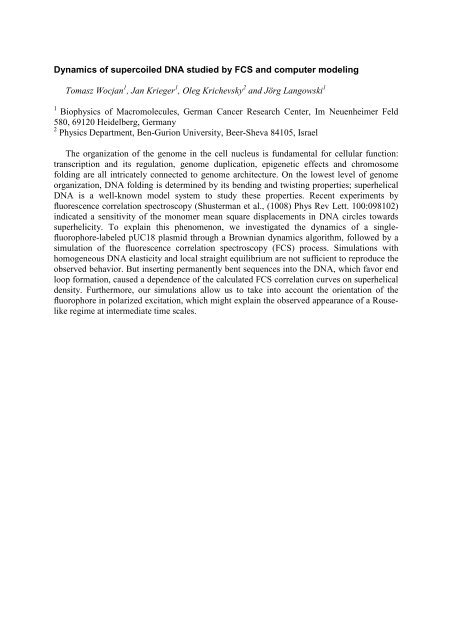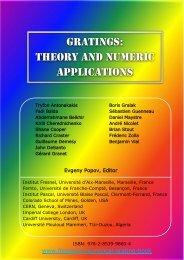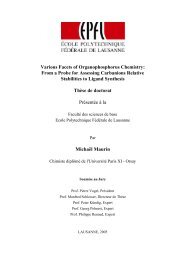12th Carl Zeiss sponsored workshop on ... - Institut Fresnel
12th Carl Zeiss sponsored workshop on ... - Institut Fresnel
12th Carl Zeiss sponsored workshop on ... - Institut Fresnel
Create successful ePaper yourself
Turn your PDF publications into a flip-book with our unique Google optimized e-Paper software.
Dynamics of supercoiled DNA studied by FCS and computer modeling<br />
Tomasz Wocjan 1 , Jan Krieger 1 , Oleg Krichevsky 2 and Jörg Langowski 1<br />
1<br />
Biophysics of Macromolecules, German Cancer Research Center, Im Neuenheimer Feld<br />
580, 69120 Heidelberg, Germany<br />
2<br />
Physics Department, Ben-Guri<strong>on</strong> University, Beer-Sheva 84105, Israel<br />
The organizati<strong>on</strong> of the genome in the cell nucleus is fundamental for cellular functi<strong>on</strong>:<br />
transcripti<strong>on</strong> and its regulati<strong>on</strong>, genome duplicati<strong>on</strong>, epigenetic effects and chromosome<br />
folding are all intricately c<strong>on</strong>nected to genome architecture. On the lowest level of genome<br />
organizati<strong>on</strong>, DNA folding is determined by its bending and twisting properties; superhelical<br />
DNA is a well-known model system to study these properties. Recent experiments by<br />
fluorescence correlati<strong>on</strong> spectroscopy (Shusterman et al., (1008) Phys Rev Lett. 100:098102)<br />
indicated a sensitivity of the m<strong>on</strong>omer mean square displacements in DNA circles towards<br />
superhelicity. To explain this phenomen<strong>on</strong>, we investigated the dynamics of a singlefluorophore-labeled<br />
pUC18 plasmid through a Brownian dynamics algorithm, followed by a<br />
simulati<strong>on</strong> of the fluorescence correlati<strong>on</strong> spectroscopy (FCS) process. Simulati<strong>on</strong>s with<br />
homogeneous DNA elasticity and local straight equilibrium are not sufficient to reproduce the<br />
observed behavior. But inserting permanently bent sequences into the DNA, which favor end<br />
loop formati<strong>on</strong>, caused a dependence of the calculated FCS correlati<strong>on</strong> curves <strong>on</strong> superhelical<br />
density. Furthermore, our simulati<strong>on</strong>s allow us to take into account the orientati<strong>on</strong> of the<br />
fluorophore in polarized excitati<strong>on</strong>, which might explain the observed appearance of a Rouselike<br />
regime at intermediate time scales.













